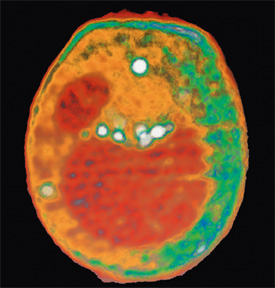
X-Ray and Ultrafast Science, page three

This x-ray tomography image of a yeast cell was taken at ALS beamline 6.1.2. Internal organelles are color coded according to x-ray absorption, with the nucleus and large vacuole shown as red, lipid droplets as white, and other cytoplasmic structures as either orange or green.
Although the primary reason for retrofitting the ALS with superbends was to help meet the huge demand for protein crystallography research, the ALS also remains one of the world’s best tools for state-of-the-art research in materials science, chemistry, physics, and the environmental sciences. For example, a team of scientists used the ALS to determine that carbon-containing aerosols remain in the atmosphere much longer than previously thought — meaning they have more time to influence the Earth’s climate. The results, based on high-resolution images, will help climate scientists refine the computer models used to predict climate change. The images reveal that aerosol particles oxidize more slowly than earlier estimates indicated, which buys them more time to waft about in the atmosphere.
“Moore’s Law,” Gordon Moore’s prediction that the density of circuit elements on microchips will double every 12 to 18 months, has held true for the past 30 years. But if it is to continue to be the law for computer chips, new fabrication techniques will be needed. At the ALS, a consortium of industry and government labs has constructed the first prototype machine for measuring (and even printing) test computer chips using extreme ultraviolet light. Microprocessors based on this technology will operate ten times faster than today’s most powerful chips and are expected to come to market by 2007.
To learn how organisms work at the cellular level, a first-of-its-kind x-ray microscope built for the ALS holds forth the promise of “CT scans” for biological cells, and other unprecedented capabilities for cell and molecular biology studies. The new microscopy resource also promises a better understanding of human diseases at the molecular level and possibly new discoveries for treating those diseases.
In the quest to determine the chemical composition of solids with greater and greater accuracy, Berkeley Lab scientists are also using extremely short laser bursts that span one-quadrillionth of a second. These femtosecond-length laser bursts are used to zap a substance’s surface and dislodge an aerosolized plume of particles that can be spectroscopically analyzed. The technique is much more sensitive than similar systems that rely on longer, nanosecond-length laser bursts, and may revolutionize scientists’ ability to quickly and accurately analyze the chemical makeup of any solid—from nuclear material and hazardous waste to Martian rocks.